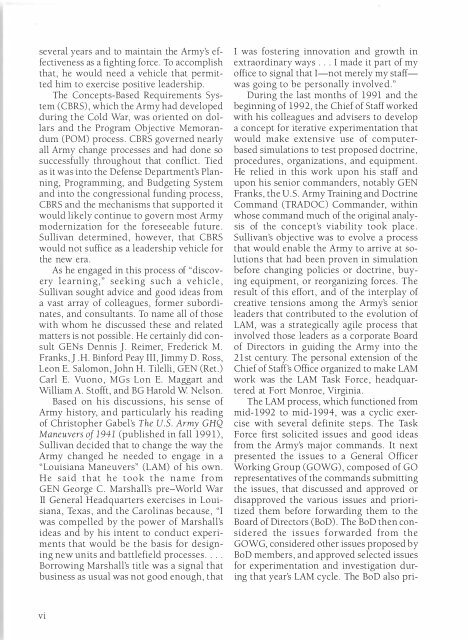The Modern Louisiana Maneuvers - US Army Center Of Military History
The Modern Louisiana Maneuvers - US Army Center Of Military History
The Modern Louisiana Maneuvers - US Army Center Of Military History
You also want an ePaper? Increase the reach of your titles
YUMPU automatically turns print PDFs into web optimized ePapers that Google loves.
several years and to maintain the <strong>Army</strong>'s effectiveness<br />
as a fighting force. To accomplish<br />
that, he would need a vehicle that permitted<br />
him to exercise positive leadership.<br />
<strong>The</strong> Concepts-Based Requirements System<br />
(CBRS), which the <strong>Army</strong> had developed<br />
during the Cold War, was oriented on dollars<br />
and the Program Objective Memorandum<br />
(POM) process. CBRS governed nearly<br />
all <strong>Army</strong> change processes and had done so<br />
successfully throughout that conflict. Tied<br />
as it was into the Defense Department's Planning,<br />
Programming, and Budgeting System<br />
and into the congressional funding process,<br />
CBRS and the mechanisms that supported it<br />
would likely continue to govern most <strong>Army</strong><br />
modernization for the foreseeable future.<br />
Sullivan determined, however, that CBRS<br />
would not suffice as a leadership vehicle for<br />
the new era.<br />
As he engaged in this process of "discovery<br />
learning," seeking such a vehicle,<br />
Sullivan sought advice and good ideas from<br />
a vast array of colleagues, former subordinates,<br />
and consultants. To name all of those<br />
with whom he discussed these and related<br />
matters is not possible. He certainly did consult<br />
GENs Dennis ]. Reimer, Frederick M.<br />
Franks,] .H. Binford Peay III, jimmy D. Ross,<br />
Leon E. Salomon, john H. Tilelli, GEN (Ret.)<br />
Carl E. Vuono, MGs Lon E. Maggart and<br />
William A. Stofft, and BG Harold W Nelson.<br />
Based on his discussions, his sense of<br />
<strong>Army</strong> history, and particularly his reading<br />
of Christopher Gabel's <strong>The</strong> U.S. <strong>Army</strong> GHQ<br />
<strong>Maneuvers</strong> of 1941 (published in fall 1991) ,<br />
Sullivan decided that to change the way the<br />
<strong>Army</strong> changed he needed to engage in a<br />
"<strong>Louisiana</strong> <strong>Maneuvers</strong>" (LAM) of his own.<br />
He said that he took the name from<br />
GEN George C. Marshall's pre-World War<br />
II General Headquarters exercises in <strong>Louisiana</strong>,<br />
Texas, and the Carolinas because, "I<br />
was compelled by the power of Marshall's<br />
ideas and by his intent to conduct experiments<br />
that would be the basis for designing<br />
new units and battlefield processes . ...<br />
Borrowing Marshall's title was a signal that<br />
business as usual was not good enough, that<br />
vi<br />
I was fostering innovation and growth in<br />
extraordinary ways . .. I made it part of my<br />
office to Signal that I-not merely my staffwas<br />
going to be personally involved."<br />
During the last months of 1991 and the<br />
beginning of 1992, the Chief of Staff worked<br />
with his colleagues and advisers to develop<br />
a concept for iterative experimentation that<br />
would make extensive use of computerbased<br />
simulations to test proposed doctrine,<br />
procedures, organizations, and equipment.<br />
He relied in this work upon his staff and<br />
upon his senior commanders, notably GEN<br />
Franks, the u.S. <strong>Army</strong> Training and Doctrine<br />
Command (TRADOC) Commander, within<br />
whose command much of the original analysis<br />
of the concept's viability took place.<br />
Sullivan's objective was to evolve a process<br />
that would enable the <strong>Army</strong> to arrive at solutions<br />
that had been proven in simulation<br />
before changing policies or doctrine, buying<br />
equipment, or reorganizing forces. <strong>The</strong><br />
result of this effort, and of the interplay of<br />
creative tensions among the <strong>Army</strong>'s senior<br />
leaders that contributed to the evolution of<br />
LAM, was a strategically agile process that<br />
involved those leaders as a corporate Board<br />
of Directors in gUiding the <strong>Army</strong> into the<br />
21st century. <strong>The</strong> personal extension of the<br />
Chief of Staff's <strong>Of</strong>fice organized to make LAM<br />
work was the LAM Task Force, headquartered<br />
at Fort Monroe, Virginia.<br />
<strong>The</strong> LAM process, which functioned from<br />
mid-1992 to mid-1994, was a cyclic exercise<br />
with several definite steps. <strong>The</strong> Task<br />
Force first solicited issues and good ideas<br />
from the <strong>Army</strong>'s major commands. It next<br />
presented the issues to a General <strong>Of</strong>ficer<br />
Working Group (GOWG), composed of GO<br />
representatives of the commands submitting<br />
the issues, that discussed and approved or<br />
disapproved the various issues and prioritized<br />
them before forwarding them to the<br />
Board of Directors (BoD). <strong>The</strong> BoD then considered<br />
the issues forwarded from the<br />
GOWG, considered other issues proposed by<br />
BoD members, and approved selected issues<br />
for experimentation and investigation during<br />
that year's LAM cycle. <strong>The</strong> BoD also pri-
















